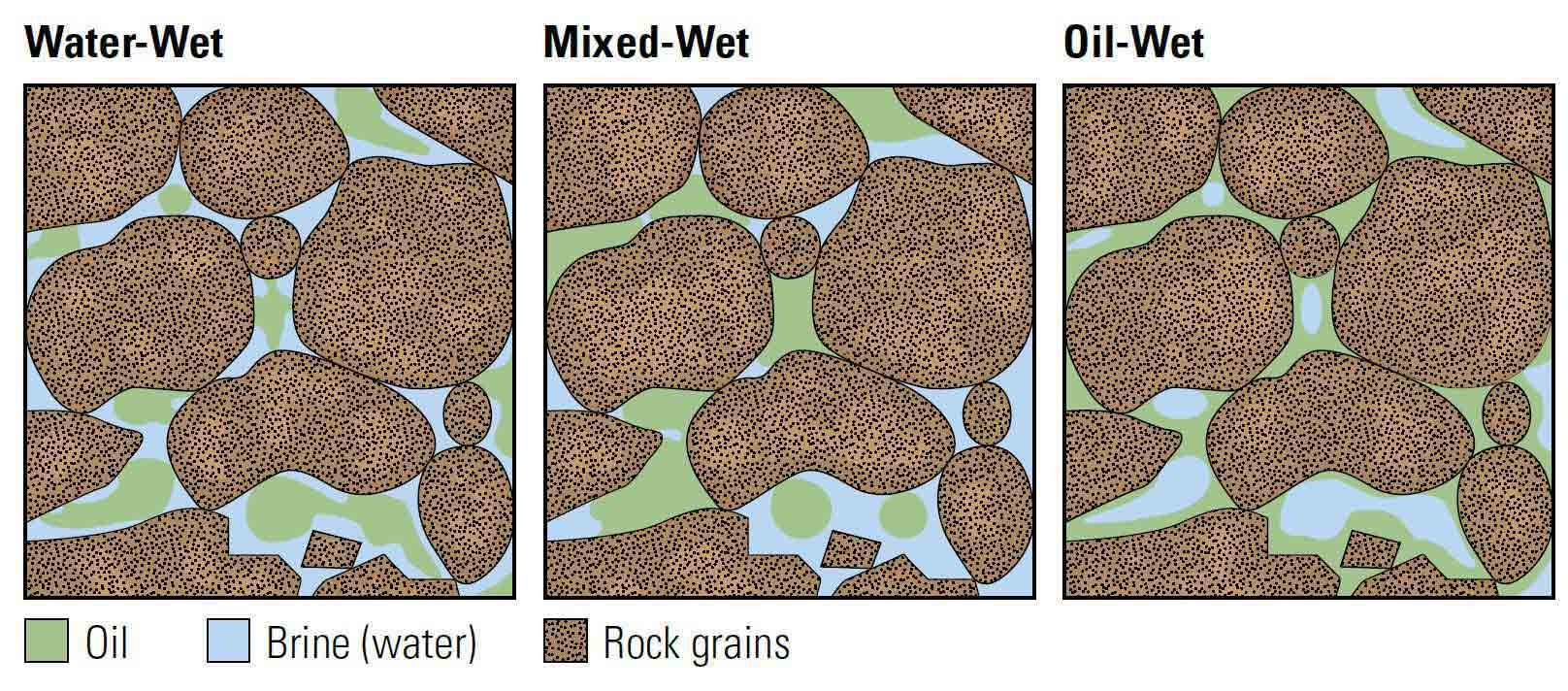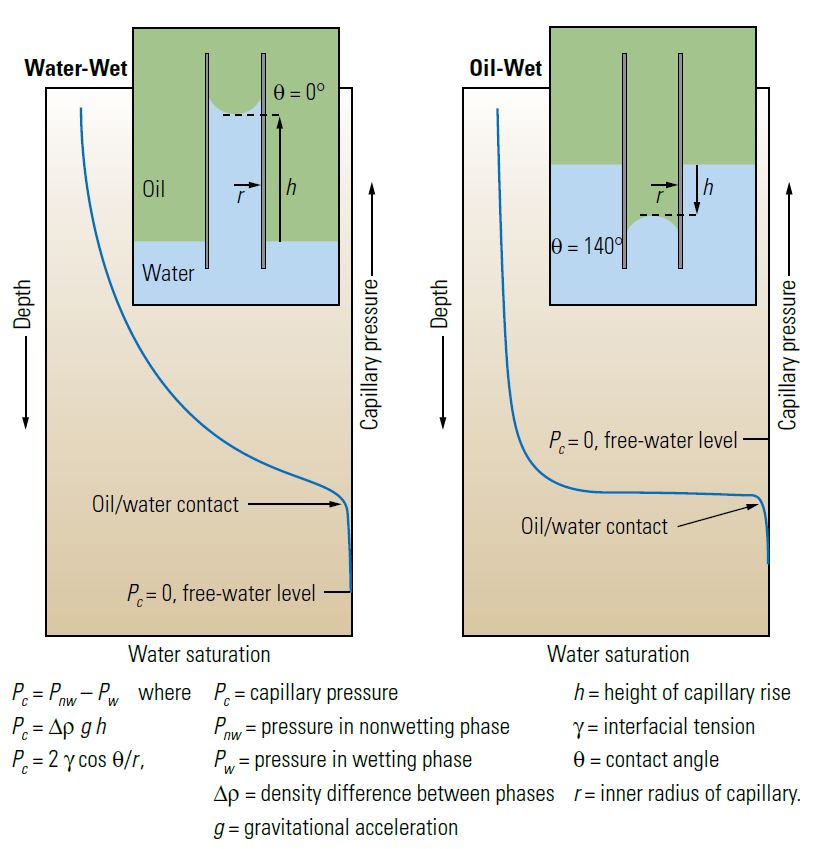The Defining Series: Wettability

The Defining Series: Wettability

Understanding formation wettability is essential for optimizing oil recovery. The oil-versus-water wetting preference influences many aspects of reservoir performance, particularly its effects on waterflooding and enhanced oil recovery techniques. Developing an oil-wet reservoir as if it is water-wet can lead to irreversible reservoir damage and reduced recovery.
Wettability describes a preference of a solid surface to be in contact with one fluid rather than another. In reservoir rock, the solid surface is composed of mineral grains, and the fluids in the pore space are typically an immiscible combination of water, oil and gas. The balance of forces—surface tensions—controls wettability between the solid and the fluids and the interfacial tension between the fluids. Surface tension results from the natural tendency of molecules at a fluid interface to be at a higher energy state than those in the bulk of a fluid. This tendency creates a reduced concentration of molecules close to the fluid interface, and the fluid molecules are pulled toward the fluid interior, imparting an adhesive force. This force, found at surfaces between immiscible fluids, is surface tension at gas/liquid boundaries and interfacial tension in liquid/liquid boundaries.
A drop of a preferentially wetting fluid will displace a nonwetting fluid from a solid surface. At the extreme, the wetting fluid will spread over the entire surface. Conversely, if a nonwetting fluid is dropped onto a surface already covered by the wetting fluid, it will bead up, minimizing its contact with the solid. If the condition is neither strongly water-wetting nor strongly oil-wetting, the balance of forces in the wetting fluid, nonwetting fluid and solid system will result in a contact angle, 0, at the point at which the two fluids and solid surface touch, forming a three-phase contact line (Figure 1).

In a homogeneous, porous material saturated with oil and water, "strongly water-wetting" describes one end of a continuum in which the pore surfaces prefer contact with water. A strongly oil-wetting surface prefers contact with oil. Degrees of wetting apply along the continuum, and if the solid does not have a marked preference for one fluid over the other, its condition is termed intermediate wetting or neutral wetting. In many oil-field applications, wettability is considered binary—the rock is either water-wet or oil-wet. This extreme simplification masks the complexity of wetting physics in reservoir rock.
The saturation history of the material may influence surface wetting; that is, pore-wall surfaces previously contacted by oil may be oil-wet, but those never contacted by oil may be water-wet. Various terms describe such heterogeneous wetting, including mixed, fractional and Dalmatian—spotty—wetting. In mixed wetting, small pores occupied by water are water-wet, while larger pores contain oil and are oil-wet. In fractional wetting, variations in minerals, which have differing surface chemical properties, cause portions of rock to be water-wet and other portions to be oil-wet. In Dalmatian wetting, the solid surface property itself may differ in patches due to mineral heterogeneity. Wetting scenarios may assume strong wetting for one fluid or the other and can be illustrated using an exaggerated surface film (Figure 2).

Wettability does not describe the saturation state of the rock; it describes the preference of the solid surfaces to be contacted by a fluid. Thus, a water-wet rock can be cleaned, dried and fully saturated with an alkane while the surfaces of its pores remain water-wet. An oil-saturated water-wet rock when contacted by water will spontaneously imbibe water and expel oil.
The process of imbibition refers to saturation increase for the wetting fluid, regardless of whether it is spontaneous or forced, although many use it to refer to aqueous phase intrusion. Conversely, drainage refers to an increase in saturation of the nonwetting fluid, typically the process of increasing oil saturation.
Measuring Wettability
Measurements on core samples include spontaneous and forced imbibition and centrifuge capillary pressure measurements. If a core sample imbibes water spontaneously but not oil, it is water-wet; if a sample imbibes oil, it is oil-wet. If the sample imbibes significant amounts of both water and oil, it is mixed-wet.
Fluid displacement methods for measuring wettability on core samples have procedural variations such as the Amott, Amott-Harvey and US Bureau of Mines (USBM).
- The Amott method involves only water imbibition.
- The Amott-Harvey method uses oil and water and provides a wettability index, calculated by subtracting the imbibed and forced oil displacement ratio from the imbibed and forced water displacement ratio.
- The USBM method reports a wettability index, which equals the logarithm of the area under the capillary pressure curve for oil displacing water minus the logarithm of the area under the centrifuge capillary pressure curve for water displacing oil; the area under a capillary pressure curve is a measure of the energy required to displace one fluid forcibly with another.
Importance of Wettability
Most oil reservoirs were water-wet before oil migrated into them. Reservoirs exhibit a transition zone through which saturation changes gradually from water—the free-water level—at the bottom of the transition zone to mostly oil with residual water, Swr—lowest or irreducible water saturation—at the top. This distribution results from the buoyancy-based pressure difference between oil and water, and the pressure difference is equal to the capillary pressure, Pc (Figure 3).
Figure 3. Forming a transition zone. A homogeneous formation exhibits a zone of transition from high oil saturation at the top to high water saturation at the bottom (blue curves). This saturation transition has its origin in the capillary pressure, Pc (equations, above). In a capillary tube, water-wetting surface forces cause water to rise (left inset), displacing oil, but if the tube inner surface is oil-wetting, the oil will push water down (right inset). The balance of wetting forces and the weight of fluid displaced from the bulk-fluid interface determine the capillary rise, h. Translating this to a porous formation, a free-water level (FWL) is defined where the capillary pressure between water and oil is zero. Since porous rocks have a distribution of pore and pore-throat sizes—similar to a distribution of capillary tubes—at any given height above the FWL, the portion of the size distribution that can sustain water at that height will be water-saturated. At greater height, the buoyancy of oil in water provides greater capillary pressure to force water out of smaller voids. In a water-wet formation (left), the oil/water contact is above the FWL; as a result, forcing oil into the largest pores requires applying pressure. In an oil-wet formation (right), the contact is below the FWL; as a result, forcing the water phase into the largest pores requires applying pressure. The oil/water contact divides the zone containing mostly oil from the one containing mostly water.

Wetting heterogeneity can affect oil recovery, for example, when a reservoir is in contact with adjacent strata and the water-wet layers and oil-wet layers have similar permeabilities. A waterflood that has vertical capillary equilibrium should produce a higher water saturation in the water-wet layers than in the oil-wet layers because the invading water will preferentially displace the wetting-phase water. Depending on the interwell spacing and the layer thickness, a waterflood may leave substantial oil in the oil-wet layers and yield high water-cut in the production stream because the injected water cannot move oil from oil-wet surfaces as easily it can move the free water in the pores.
Wettability also affects the amount of oil produced at the end of oil displacement and recovery by waterflooding as measured by the residual oil saturation, Sor. At the pore level in a water-wet formation, water flows into all accessible pores, and the remaining oil remains isolated in large pores, disconnected from an oil-connected pathway. In a strongly oil-wet formation, oil adheres to surfaces, increasing the probability of a continuous oil-connected path to a producing well and resulting in a lower Sor than that in a water-wet formation. However, this connected oil may have very low mobility because of its confinement to small pores.
The wetting states of layers within formations can also differ because of lithology variations. A tight, low-permeability zone may remain water-wet if little or no oil migrates into it while surrounding formations can become more oil-wet. Wetting can also be affected by temperature variations and the connate water pH.
Because its impact extends from pore scale to reservoir scale, wettability can affect project economics. Reservoir engineers use the parameters Swr and Sor to predict the amount of oil that can be recovered. These parameters are directly affected by wettability. In addition, the relative permeabilities of oil and water vary with formation wettability; relative permeability is the relative ease that one fluid has to flow through the pore space in the presence of other fluids. In projects that have large upfront capital expenditures for facilities, such as those in deepwater areas, failure to understand wettability and its ramifications through both residual saturations and relative permeability can be costly.
Reservoir engineers design enhanced oil recovery processes to alter wettability to water-wet to remove oil contacting the solid surface. Alternatively, rendering the formation to be oil-wet may improve ultimate oil recovery.
Wettability may also influence gasflood performance. The gasflood front or oil bank can move water, if it is mobile, generating flow variation based on oil/water wetting preferences. In addition, if asphaltenes are present in the crude oil, contact by injected hydrocarbon gas alters the equilibrium condition, possibly causing precipitation of asphaltenes, which can plug pores.
Even in a gas reservoir, wettability or its alteration can affect recovery. Blockage by condensate formed near a wellbore—condensate banking—during depletion of a gas reservoir decreases gas productivity. Some recovery methods use chemical means to alter the wettability around the wellbore to produce the fluids and clear the blockage.
Wetting conditions affect some logging measurements. Most resistivity measurements rely on a continuous, conductive electrical path through the rocks, which the water phase provides. In an oil-wet formation, the water may not be continuous, especially if the well is drilled with oil-base mud. In these conditions, a resistivity-based saturation assessment such as that with Archie's equation will likely be incorrect if used without considering phase connectivity.
Nuclear magnetic resonance (NMR) responses also depend on the position of the fluids with respect to the pore surfaces. The nonwetting fluid exhibits NMR relaxation rates similar to those of bulk fluid if the fluid does not contact the pore surface. The wetting fluid has shortened relaxation times because of its interactions with the pore surface.
Wettability is important to drilling-fluid formulation, particularly in oil-base muds. Surfactants keep solids in suspension. If an oil-external mud filtrate containing oil-wetting surfactants invades the near-well formation, there is a potential to alter the wettability of the pores. This process can change the position of the fluids in the pore spaces and may affect some logging responses. Because the alteration may not be permanent, measurements may differ in subsequent logging runs.
Fields around the world are maturing, but the industry still needs to extract as much of the hydrocarbon resource as is economically possible before these fields are abandoned. To optimize recovery, operators must understand the effects of wettability on well production and field performance.
Oilfield Review 2016
Copyright © 2016 Schlumberger.
